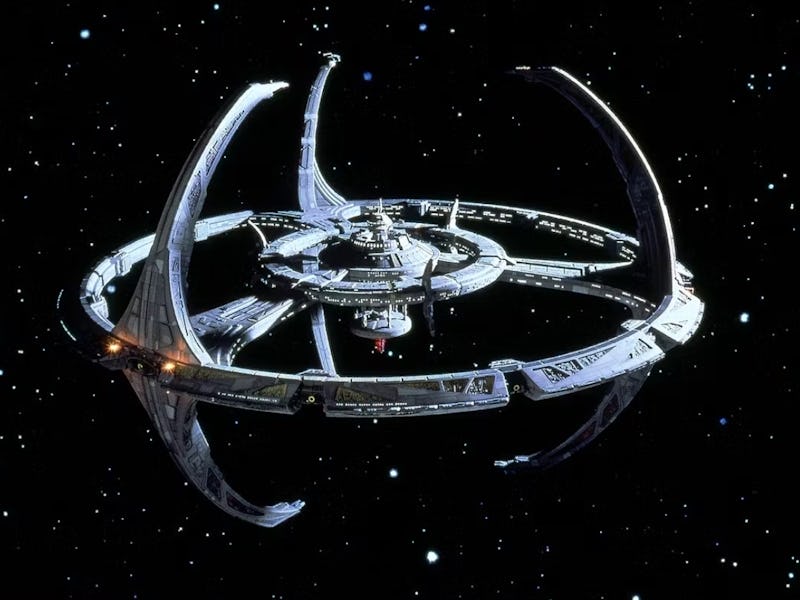A Quarter-Century Later, Deep Space Nine’s Finale is a Bridge Between Old and New Star Trek
We’ve left this era behind.

In the final season of Star Trek: Deep Space Nine, our heroes take desperate measures to achieve victory in a bitter war that’s engulfed billions of lives across the galaxy. They also play a rousing game of baseball.
Wedged between The Next Generation, a beloved revival, and Voyager, a mediocre Borg adventure factory, Deep Space Nine’s creators were largely free to take their black sheep where they saw fit. The result was a series that moved Star Trek towards nuanced serialized storytelling, while still finding time to dabble in episodes about Vulcan serial killers and ill-advised crossdressing. When it wrapped up both its serious and silly stories in one big finale, DS9 built a bridge between the one-off episodes of Star Trek past and the relentless season-long sagas of modern shows like Discovery and Picard.
“What You Leave Behind” had to conclude the Federation’s brutal conflict with the Dominion, while also providing closure to Captain Sisko’s uneasy role as a Bajoran religious figure. Both storylines had percolated in the background for years before exploding in DS9’s final seasons, and both highlighted the strengths of the show’s unique fixed setting. Set in a space station above a Bajor struggling to survive its newfound independence and adjacent to a wormhole leading to a far-flung region of space defined by the Dominion’s cruelty, the set-up allowed the consequences of our heroes’ adventures to fester for years.
In an eventful final season, Major Kira (Nana Visitor) is given command of Deep Space Nine and learns the infield fly rule.
The war against the Dominion — essentially an anti-Federation that subjugated new members to make itself more powerful and conniving — is the finale’s strongest element. The multi-season struggle had touched on weighty themes like war crimes and the morality of violent resistance, and it’s satisfying to see Sisko and his stalwart crew battle their way to a melancholy victory. The whole saga is one of the few times Star Trek embraced an epic scope rather than focus on a single ship’s isolated adventures, and seeing characters we knew for years become key cogs in a grand war machine was a somber escalation of the stakes.
Captain Sisko’s personal denouement was less successful. His unique connection to the mysterious aliens living in the wormhole, which the Bajorans worship as prophetic gods, worked well as a symbol of his series-long transition from jaded cynic to fierce protector of Bajor. But “What You Leave Behind” attempted to give this spiritual tale an action-y finale featuring Gul Dukat, a long-running Cardassian villain and occasional uneasy frenemy. Dukat’s saga as an opportunistic Dominion lackey reached a natural conclusion in Season 6, yet he was brought back as a sort of Bajoran Antichrist stuffed full of ham. It felt like an attempt to cram the finale of Raiders of the Lost Ark into the end of Saving Private Ryan.
In one of the finale’s weaker moments, Gul Dukat (Marc Alaimo) shows up like he wandered in from a ‘90s FMV game.
But a quarter-century later, what stands out are the side stories “What You Leave Behind” wraps up. While Deep Space Nine’s seventh season built towards this two-part finale, it also dabbled in asides no sci-fi drama could spare time for today. Featuring a whopping 26 episodes, Season 7 focused on the horrors and heroism of war, but also took a minute to check in on the mirror universe, stage a holosuite heist, and play ball with an arrogant Vulcan. The pacing is glacial compared to a modern show like Picard, and not every episode was a winner, but these asides enhanced the main storyline rather than distract from it. Life, even during galactic megawar, goes on.
This blend of the critical and mundane is why our heroes celebrate their grand victory in a holosuite simulation of a ‘60s Vegas lounge. The Season 6 introduction of Vic Fontaine, a holographic Rat Pack knockoff, was derided as silly and self-indulgent, and 24th-century humans and aliens turning to a pretend crooner for romantic advice and emotional solace should have been ridiculous. But Fontaine was allowed to develop across B-stories and dedicated episodes, a decision that culminated in the superb Season 7 episode “It's Only a Paper Moon.” Nog, once a comic-relief side character, turns Fontaine’s lounge into his personal fantasy realm to cope with losing a limb in battle, and the frank look at PTSD was so effective that giving Fontaine a proper sendoff in “What You Leave Behind” felt natural.
Star Trek and lounge singing, together at last.
A hokey hologram getting screentime speaks to the sheer scope of the finale, but despite its busy-ness, it managed to leave most of its characters in satisfying places. Today, the episode title offers an unintended second meaning, as Star Trek — and television in general — has largely abandoned Deep Space Nine’s supersized seasons and leisurely storytelling pace. Amid its many side stories, DS9 helped move Trek towards the modern serial format, which can make the lean 10-episode seasons of Picard feel like nothing but one exhausting crisis after another. Such momentum can be thrilling, but we’ve lost something in not getting to better know our heroes as they enjoy a little downtime.
With Discovery over, Lower Decks on the way out, and several new shows and movies in the works, Star Trek is once again entering a season of change. It’s difficult to imagine big-budget sci-fi ever returning to 26-episode seasons, but revisiting “What You Leave Behind” still offers a valuable lesson. Viewers wanted to see Deep Space Nine’s heroes triumph over the Dominion not because their battles had been so dramatic, but because we’d spent enough time with them to know they deserved peace.